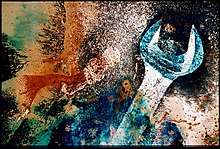Chemogram
A chemogram (from "chemistry", "optic" and gramma, Greek for "things written")[1] is an experimental art where a photographic image is partly or fully enlarged and processed onto photographic paper in the darkroom and afterwards selectively painted over in full light with chemicals used in photographic processing. Due to the production process chemograms can be considered works of abstract photography.
.jpg)
Chemograms were invented in 1974 by the German photo artist Josef H. Neumann.
History

Chemograms are advancements of chemigrams, which were originally invented by the Belgian artist Pierre Cordier in 1956. Although Johann Schulze, Hippolyte Bayard, Maurice Tabard and Edmund Kesting had experimented in obtaining chemigram-like images before, Pierre Cordier is considered the pioneer of the chemigram and of its development as a means of artistic expression.
The term "chemogram" (German: "Chemogramm") was coined in 1976 by the photo designer Josef H. Neumann from Dortmund. He had learned the technique of creating chemigrams from his Professor Pan Walther,[2] who had adopted it from Edmund Kesting – both coming from Dresden.
In the production process Neumann did not only use brush or wad of cotton wool but he also processed photos onto the photographic paper before that.[3] As the optic during the production process played a decisive role for him, he changed the term "chemigram" by replacing the letter „i“ with „o“.[4] This way the first pieces of this technique were created at the Dortmund University of Applied Sciences and Arts from 1974 to 1976.[5] The first chemograms were exhibited in 1976 at the "Fotografik Studio Gallerie Prof. Pan Walther" in Münster.[6]
Process
A chemogram is a product of both photographic processing and painting on photographic paper. Unlike chemigrams the production process of chemograms consists of two different steps. First an enlarger is used to partly or fully process a photographic image onto photographic paper in the darkness of the darkroom. As soon as the preferred development of the image is reached, the photographic process is interrupted and the photographic paper is exposed to full light and treated with developer and fixer (or other chemicals) like a chemigram. The procedure can be repeated until the chemogram is finished.[7]
During the first part of the production the artist Josef H. Neumann had full control over the selection of the picture and the duration of the photographic processing, while in the second part the control remains only at the places where the colorless chemicals are applied. The exact reactions of the chemicals that produce the final colors at these locations are largely unpredictable. Thus, these first chemograms by Josef H. Neumann (1974-1978) originated as absolute pieces that can not be reproduced in the original creative process.(Unique)
Notes
- "-gram". The New Oxford American Dictionary (2nd ed.).
- Hannes Schmidt: Bemerkungen zu den Chemogrammen von Josef Neumann. Ausstellung in der Fotografik Studio Galerie von Prof. Pan Walther. in: Photo-Presse. Heft 22, 1976, p. 6.
- Gabriele Richter: Joseph H. Neumann. Chemogramme. in: Color Foto. Heft 12, 1976, p. 24.
- Harald Mante, Josef H. Neumann: Filme kreativ nutzen. Photographie Verlag, Schaffhausen 1987, pp. 94-95.
- "Thema 3 - Die Hochglanzwelt des Josef H. Neumann in Stadtjournal by WDR" (in German).
- Hannes Schmidt: Bemerkungen zu den Chemogrammen von Josef Neumann. Ausstellung in der Fotografik Studio Galerie von Prof. Pan Walther. in: Photo-Presse. Heft 22, 1976, p. 6.
- Harald Mante, Josef H. Neumann: Filme kreativ nutzen. Photographie Verlag, Schaffhausen 1987, pp. 94-95.
References
- (in German) Richter, Gabriele (1976). "Joseph H. Neumann. Chemogramme". Color Foto. München, Germany. 12: 24.
- (in German) Schmidt, Hannes (1976). "Bemerkungen zu den Chemogrammen von Josef Neumann. Ausstellung in der Fotografik Studio Galerie von Prof. Pan Walther" [Remarks on Josef Neumann's chemograms. Exhibition in the Fotografik Studio Galerie of Prof. Pan Walther]. Photo-Presse. Hamburg, Germany. 22: 6.
- (in German) Mante, Harald; Neumann, Josef H. (1987). Filme kreativ nutzen. Schaffhausen 1987: Photographie. pp. 94–95. ISBN 3-7231-7600-3.CS1 maint: location (link)